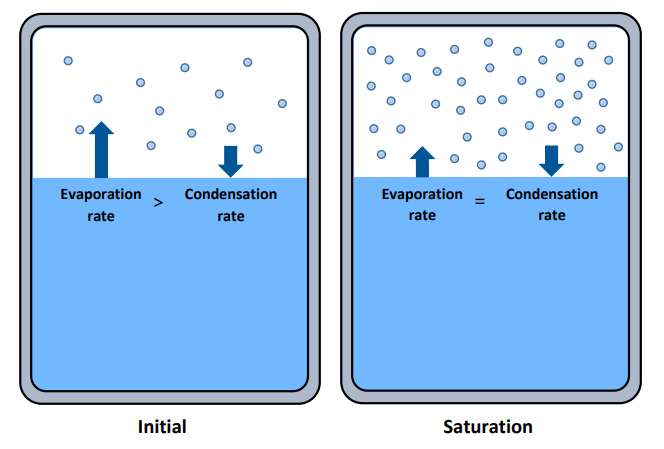Let's Talk about Relative Humidity
Let's Talk about Relative Humidity
SO Chi-wai Andy
May 2024
“A dry northeast monsoon is affecting the coast of Guangdong. The relative humidity in the territory generally fell to about 40 percent in the afternoon.” If you pay attention to weather reports, the term “relative humidity” should be familiar to you. But what exactly is relative humidity? Why “relative”? How is it measured?
Absolute humidity and relative humidity
Absolute humidity is the mass of water vapour per unit volume of the air in which the vapour is contained, usually expressed in the unit of g/m3. It is a measure of the actual amount of water vapour in the air.
Relative humidity is the ratio of the actual water vapour pressure in the air to the saturation vapour pressure of water at the same temperature, usually expressed in percent (%).
What is saturation vapour pressure then? Imagine a closed container with water at room temperature and assume constant temperature. Initially, some water molecules at the surface with sufficient kinetic energy will evaporate as water vapour and leave the liquid water body. Some of the water vapour in the air will condense again as liquid water. This process will continue until an equilibrium is reached, that is, when the number of returning molecules becomes identical to the number of escaping molecules. At that time, the air in the container cannot hold any more water vapour and is said to be saturated (Figure 1). Under such condition, the pressure exerted by the water vapour on the water surface is called the saturation vapour pressure. Saturation vapour pressure depends on temperature. At a higher temperature, the air can hold more water vapour and the corresponding saturation vapour pressure will increase, vice versa.
In layman’s terms, relative humidity can be understood as the ratio of the actual amount of water vapour in the air relative to the maximum amount of vapour that can exist in the air at the same temperature. If we assume the actual amount of water vapour in the air does not change (absolute humidity is constant), when air temperature falls, the maximum amount of vapour that can be held by the colder air will become less (i.e. saturation vapour pressure decreases). This will result in an increase in the relative humidity. Under clear skies with significant night-time radiative cooling, the temperature drop may cause the near-ground air to become saturated with water vapour condensing to form water droplets (i.e. dew). As such, the air temperature to which it must be cooled to become saturated is called dew point temperature.

Figure 1 With the evaporation rate initially greater than the condensation rate, the pressure exerted by water vapour on the water surface (i.e. vapour pressure) will build up until saturation is reached when the evaporation rate is equal to the condensation rate. At saturation, this pressure is called the saturation vapour pressure.
Measuring relative humidity
There are three common methods of measuring relative humidity.
Computation using dry- and wet-bulb temperatures: Dry-bulb temperature is simply the air temperature. Wet-bulb temperature is read on a thermometer whose bulb is covered in a water-soaked cloth. Due to evaporative cooling of water on the cloth, wet-bulb temperature is generally lower than dry-bulb temperature. The evaporation rate depends on the amount of water vapour in the air. Under drier air, evaporation is faster and the difference between dry-bulb and wet-bulb temperature is larger. Therefore, the difference between dry-bulb and wet-bulb temperature reflects how far from saturation the air is and can be used to compute the relative humidity. Historically, various methods have been adopted by the Observatory to compute the relative humidity, including the use of hygrometric tables, slide rules (Figure 2) and formulas. Currently, relative humidity is computed using the modified Hooper’s method[1].
Resistive humidity probes: measure the variation in resistance of a material whose conductivity changes with humidity.
Capacitive humidity probes: measure the variation in capacitance of a dielectric caused by changes in humidity. This type of probes are used at some automatic weather stations of the Observatory.

Figure 2 Humidity slide rules.
Recovery of post-war historical relative humidity records
Previously, the Observatory website only provided relative humidity data starting from 1961. As for the post-war period from 1947 to 1960, relative humidity data are recorded in the weather logbooks kept at the Observatory Headquarters (Figure 3). The Observatory recently quality-checked and digitised these historical relative humidity data, and added them to the Observatory’s database. The daily, monthly and yearly mean relative humidity data recorded at the Observatory Headquarters from 1947 to 1960 were published online in November 2023.
Hong Kong has experienced some extremely dry weather events since WW II, including a prolonged drought in 1963 which resulted in an annual mean relative humidity of only 73%, the driest year on record. January of that year was also the driest month on record with a mean relative humidity of only 45%. The mean relative humidity on 16 January 1955 was 21%, the lowest daily value on record. Based on the hourly observations at the Observatory Headquarters, the lowest absolute minimum relative humidity appeared on 16 January 1959, with a relative humidity of only 10% recorded at 3 pm that day (Figure 4).

Figure 3 Weather logbook used in 1947 with hourly relative humidity recorded on the last row.

Figure 4 Excerpt of hourly weather observations on 16 January 1959. The relative humidity recorded at 3 pm was only 10%, the lowest absolute minimum relative humidity ever recorded.
Reference:
[1] Meteorological Magazine, No. 1297, Volume 109 “Computation of vapour pressure, dew point and relative humidity from dry- and wet-bulb temperatures”, G.P. Sargent, 1980
[1] Meteorological Magazine, No. 1297, Volume 109 “Computation of vapour pressure, dew point and relative humidity from dry- and wet-bulb temperatures”, G.P. Sargent, 1980